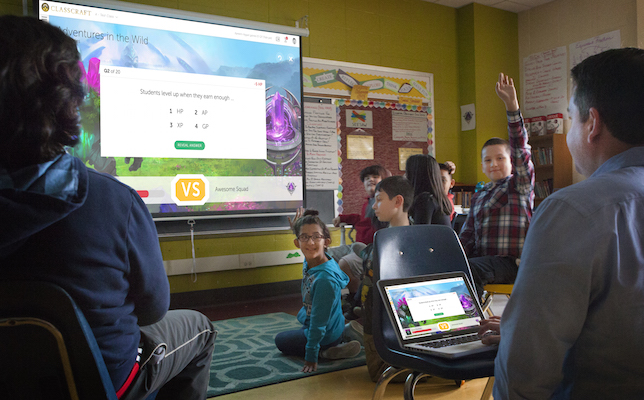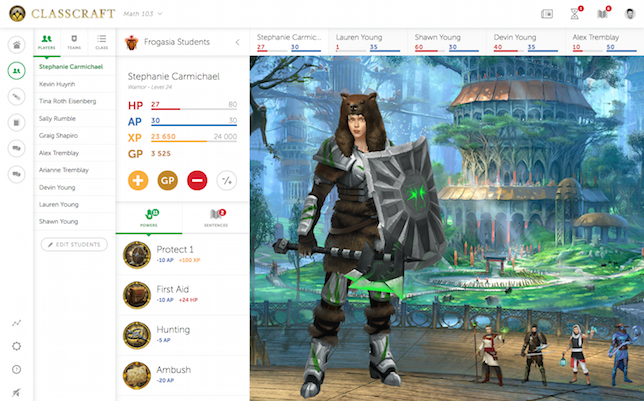Fantasy Role-Playing Game Motivates Students to Rely on Each Other to Learn

At ISTE 2017 last month, Classcraft demoed its online educational role-playing game (RPG), which is now being used in more than 75 countries as a classroom management tool. The game aims to make classroom management fun for teachers and students by putting the latter in charge of their own learning and making them rely on one another.
Classcraft was founded in 2013 by two brothers, Shawn and Devin Young, and their father, Lauren Young. Shawn, an 11th grade physics teacher and web developer, told THE Journal that Classcraft was born out of a role-playing game that he first introduced in his physics classes. After seeing his students play the game and actually engage in the subject matter, the Youngs spent the next several years developing Classcraft for other teachers to use.
They said they had their first big break when Classcraft was shared to Reddit and went viral — reaching upwards of 130,000 unique visits per day at the time. Now, the RPG platform is used by more than 20,000 schools in the United States and more than 2 million student users around the world, according to the company.
How it Works
Classcraft attempts to motivate students by combining real-world risks and rewards. It’s compared to “World of Warcraft” quite often, since that’s also a fantasy-themed RPG (which isn’t too far off). In Classcraft, students form teams where they are assigned one of three characters: mages, warriors and healers. Each character has unique powers that assist players throughout the course of the game. A mage, for example, can “teleport” or trade places with another player on its team, or use “invisibility” to leave class for two minutes.
In order to succeed in Classcraft, each character needs help from the other two classes. That’s because, like many other games, players have different “stats” that are impacted by the rest of their team’s performance.

First, health points or “HP” are life energy, which the teacher can add or remove depending on the student’s behavior in class. Students who are doing poorly in class or disrupting others will lose HP and can even penalize their teammates, who might be required to complete extra work or lose time on a test. Mages typically have a low amount of HP while warriors have the most, but they can ask their teammates to help restore HP.
Additionally, as students excel in class — not just academically, but socially — they can gain more experience points or “XP” that unlock real rewards (i.e., getting to use notes on a test or being able to snack in class). In the premium version of the game, gold pieces or “GP” are another reward for students that lets them customize their avatar.
To play Classcraft, only a computer and projector are needed. It can be integrated with Google Classroom and Microsoft Classroom, and it’s compatible with Chrome, Android, Windows, iOS and OS X. It can be used to gamify any existing curriculum and lessons.
Transformative for SEL, PBIS and School Culture
Teachers have reported seeing major behavioral changes within classrooms after introducing Classcraft to students.
“First, you start making students accountable in groups,” said Devin Young, the chief creative officer. “They become self-regulating and you’ll start to hear students say things like, ‘Hey, be quiet or you’ll make us lose points,’ to each other. When you’re managing a classroom and students start helping you, all of a sudden managing that classroom got a lot easier — and saves you instruction time.”
Second, the game’s fictional powers are enabling students to have real-life “hero moments” that build up students’ social and emotional learning (SEL) skills. Devin explained how these moments come about when students work in teams. “It’s based on you having a good relationship with people in your team. If you don’t and you’re giving them a hard time, they’re a lot less likely to come and help you out in the game, and over time you start building up these negative consequences that make it less fun for you.”
Finally, the Young brothers noted that Classcraft works to build a classroom and school culture where it’s OK to ask for help from others. It accomplishes this by taking a positive behavioral interventions and supports (PBIS) approach — “so awarding kids points for empathy, including other students, things like that,” Devin explained.
Shawn commented that one class of students filled with 15-year-old boys started using Classcraft and afterwards the teacher noticed they began talking about their emotions more openly to each other. “It’s really transformative when you put those social and emotional behaviors into the platform and really operate a mindshift change for students.”
Jennie Magiera, the former chief innovation officer for School District 62 in Des Plaines, IL and the Tuesday keynote speaker at ISTE 2017, has said Classcraft is a household name across the 8,000-student pre-K-8 school system.
“Social and emotional learning isn’t just about being nice and kind to one another — it’s about functioning as a person in society and being able to communicate well with others,” Magiera said in a video. “It’s about learning how to cooperate and collaborate with someone else. Classcraft meets some urgent and immediate needs that we have for our teachers to build capacity around social and emotional learning.”
Teachers can sign up individually and use the free or paid version (for about $100), or schools can purchase a license.
To learn more, visit the Classcraft site.